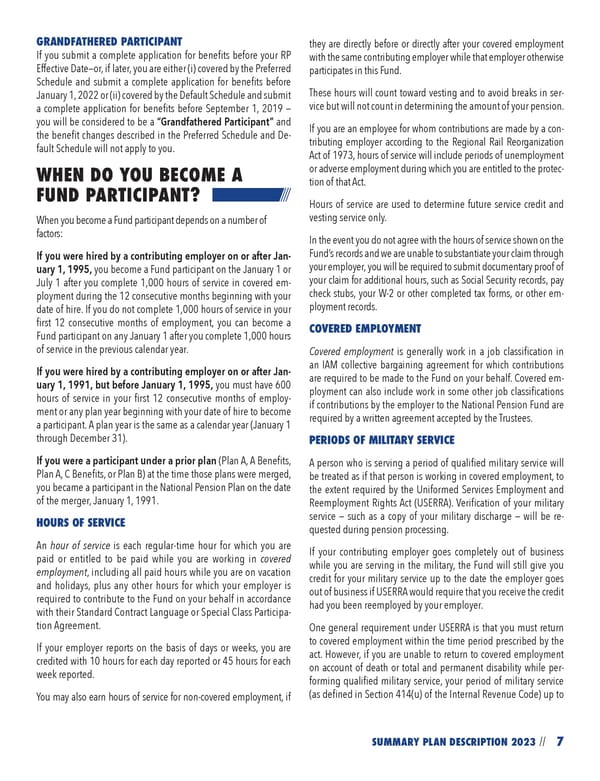7 SUMMARY PLAN DESCRIPTION 2023 // GRANDFATHERED PARTICIPANT If you submit a complete application for benefits before your RP Effective Date—or, if later, you are either (i) covered by the Preferred Schedule and submit a complete application for benefits before January 1, 2022 or (ii) covered by the Default Schedule and submit a complete application for benefits before September 1, 2019 — you will be considered to be a “Grandfathered Participant” and the benefit changes described in the Preferred Schedule and De- fault Schedule will not apply to you. WHEN DO YOU BECOME A FUND PARTICIPANT? When you become a Fund participant depends on a number of factors: If you were hired by a contributing employer on or after Jan- uary 1, 1995, you become a Fund participant on the January 1 or July 1 after you complete 1,000 hours of service in covered em- ployment during the 12 consecutive months beginning with your date of hire. If you do not complete 1,000 hours of service in your first 12 consecutive months of employment, you can become a Fund participant on any January 1 after you complete 1,000 hours of service in the previous calendar year. If you were hired by a contributing employer on or after Jan- uary 1, 1991, but before January 1, 1995, you must have 600 hours of service in your first 12 consecutive months of employ- ment or any plan year beginning with your date of hire to become a participant. A plan year is the same as a calendar year (January 1 through December 31). If you were a participant under a prior plan (Plan A, A Benefits, Plan A, C Benefits, or Plan B) at the time those plans were merged, you became a participant in the National Pension Plan on the date of the merger, January 1, 1991. HOURS OF SERVICE An hour of service is each regular-time hour for which you are paid or entitled to be paid while you are working in covered employment, including all paid hours while you are on vacation and holidays, plus any other hours for which your employer is required to contribute to the Fund on your behalf in accordance with their Standard Contract Language or Special Class Participa- tion Agreement. If your employer reports on the basis of days or weeks, you are credited with 10 hours for each day reported or 45 hours for each week reported. You may also earn hours of service for non-covered employment, if they are directly before or directly after your covered employment with the same contributing employer while that employer otherwise participates in this Fund. These hours will count toward vesting and to avoid breaks in ser- vice but will not count in determining the amount of your pension. If you are an employee for whom contributions are made by a con- tributing employer according to the Regional Rail Reorganization Act of 1973, hours of service will include periods of unemployment or adverse employment during which you are entitled to the protec- tion of that Act. Hours of service are used to determine future service credit and vesting service only. In the event you do not agree with the hours of service shown on the Fund’s records and we are unable to substantiate your claim through your employer, you will be required to submit documentary proof of your claim for additional hours, such as Social Security records, pay check stubs, your W-2 or other completed tax forms, or other em- ployment records. COVERED EMPLOYMENT Covered employment is generally work in a job classification in an IAM collective bargaining agreement for which contributions are required to be made to the Fund on your behalf. Covered em- ployment can also include work in some other job classifications if contributions by the employer to the National Pension Fund are required by a written agreement accepted by the Trustees. PERIODS OF MILITARY SERVICE A person who is serving a period of qualified military service will be treated as if that person is working in covered employment, to the extent required by the Uniformed Services Employment and Reemployment Rights Act (USERRA). Verification of your military service — such as a copy of your military discharge — will be re- quested during pension processing. If your contributing employer goes completely out of business while you are serving in the military, the Fund will still give you credit for your military service up to the date the employer goes out of business if USERRA would require that you receive the credit had you been reemployed by your employer. One general requirement under USERRA is that you must return to covered employment within the time period prescribed by the act. However, if you are unable to return to covered employment on account of death or total and permanent disability while per- forming qualified military service, your period of military service (as defined in Section 414(u) of the Internal Revenue Code) up to
 2023 NPF Summary Plan Description Page 8 Page 10
2023 NPF Summary Plan Description Page 8 Page 10